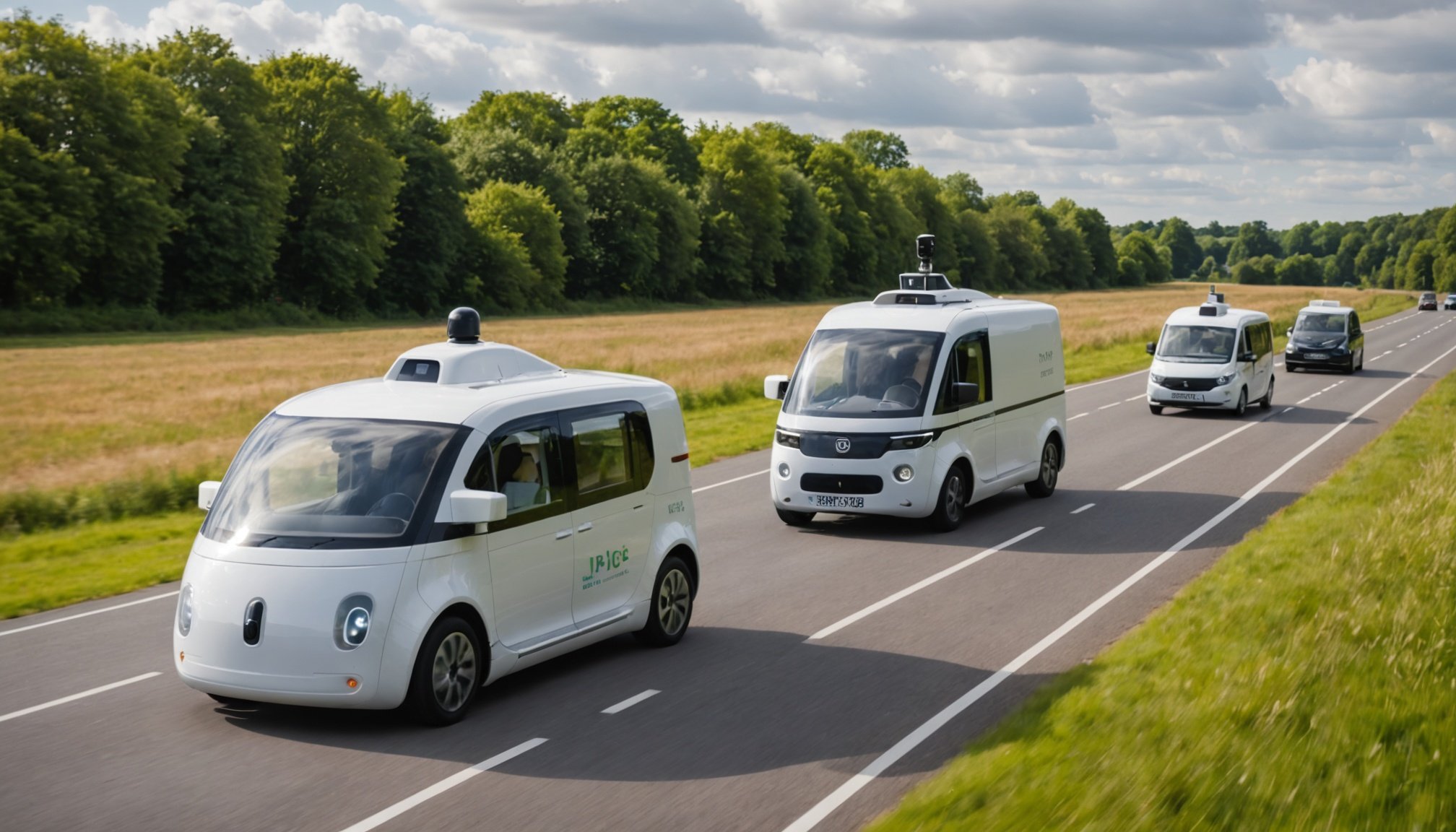Current Technologies in Self-Driving Vehicles
The rapidly evolving landscape of self-driving technology showcases tremendous innovations set to revolutionize autonomous vehicles and their application in logistics. Recent advancements include sophisticated sensor systems and enhanced decision-making algorithms powered by artificial intelligence and machine learning. These technologies enable real-time data processing, crucial for navigating complex road conditions and ensuring safety.
Key industry players are rushing to dominate this space, with giants like Google’s Waymo and Tesla at the forefront. Their dedicated research and development have pushed boundaries in crafting reliable logistics innovations. Companies such as Uber and Amazon are also exploring autonomous vehicles to optimize their delivery networks.
In parallel : Achieve Retail Brilliance: Premier Geomarketing Tactics for UK Stores
A significant benefit of self-driving technology lies in its potential to transform logistics operations. Artificial intelligence and machine learning play pivotal roles in addressing logistical challenges, particularly through route optimization and load management. These technologies facilitate the precise coordination of delivery schedules, reducing operational costs and enhancing efficiency.
The logistics industry is on the cusp of a major transformation, driven by self-driving technology and autonomous vehicles. Understanding these advancements is vital for businesses seeking to harness logistics innovations effectively, paving the way for more streamlined and cost-effective operations.
This might interest you : Revolutionizing UK Enterprises: Key Strategies to Foster a Data-Driven Mindset
Case Studies of Successful Integration
Examining successful case studies provides valuable lessons for logistics companies considering autonomous operations. One notable example is the UK’s Ocado, a leader in online grocery retail employing self-driving technology to optimize warehouse operations. By integrating autonomous vehicles, Ocado has streamlined their logistics process, leading to improved operational efficiency and cost reductions. This model demonstrates the transformative impact of autonomous vehicles in logistics innovation.
Another pioneering organization is Royal Mail, which has partnered with several technology firms to pilot trials of autonomous vehicles. These trials aim to boost delivery efficiency, decrease costs, and reduce environmental impact. Such initiatives reflect a shift towards eco-friendlier practices as part of the autonomous operations strategy.
The journey of these early adopters is not without its lessons. Royal Mail and Ocado emphasize the significance of robust compliance strategies and collaborations with tech providers. Additionally, these companies learned to adapt their existing infrastructure to seamlessly incorporate self-driving vehicles.
By analyzing successful case studies, logistics companies can gain insights into effective implementation and strategy, ensuring they leverage the full potential of autonomous vehicle technology. Such knowledge empowers businesses to improve cost-efficiency, boost sustainability, and elevate their position in a competitive landscape.
Regulatory Considerations and Compliance
Current regulations for autonomous vehicles in the UK play a crucial role in shaping the future of logistics. These laws ensure that self-driving technology is implemented safely and responsibly. However, navigating this regulatory landscape presents challenges for logistics companies. Understanding the complex web of requirements is essential for businesses eager to adopt autonomous vehicles.
In the UK, the regulatory body mandates specific safety standards and testing protocols before deployment. Penalties for non-compliance can result in costly delays or legal issues, highlighting the importance of robust compliance strategies. To ease the transition, it’s imperative that companies collaborate with legal experts and stay abreast of regulatory updates. UK logistics laws will continue to evolve as the technology matures, making it important for logistics companies to remain proactive in their compliance efforts.
One effective recommendation for ensuring compliance is to engage in continuous dialogue with regulators and other stakeholders. Such collaborations can facilitate smoother integration of autonomous vehicles into operations. Additionally, businesses should invest in training programs to keep team members informed about changing regulations and compliance requirements. Implementing these strategies not only ensures legal conformance but also enhances operational efficiency and public trust in autonomous technologies.
Practical Tactics for Implementation
As businesses consider integrating autonomous vehicles into their logistics infrastructure, following a methodical approach is critical for achieving operational efficiency. Here are some pivotal tactics that logistics companies can employ:
-
Assessment and Planning: Begin by evaluating current logistics operations to determine areas where self-driving technology will have the most impact. Develop a detailed implementation plan that outlines objectives, resources, and timelines.
-
Infrastructure Adaptation: Ensure that existing infrastructure can support autonomous vehicle integration. This includes upgrading facilities, setting up necessary technological frameworks, and establishing charging stations for electric self-driving vehicles.
-
Pilot Programs: Initiate small-scale trials to test the functionality and reliability of autonomous vehicles in real-world scenarios. These programs allow for fine-tuning operations before full-scale deployment.
-
Collaborations and Partnerships: Engaging with tech providers and industry stakeholders is crucial. These collaborations foster innovation and provide access to cutting-edge technologies and insights.
-
Training and Education: Equip your workforce with necessary skills to work alongside self-driving technology. Offer training programs focusing on new processes and safety protocols to ensure a smooth operational transition.
Implementing these strategies can help logistics companies harness the full potential of autonomous vehicles, paving the way for streamlined, cost-effective operations in a competitive market.
Analyzing Challenges and Benefits
The journey toward adopting self-driving technology in logistics is fraught with challenges and opportunities. For logistics companies, one major challenge lies in the initial high costs of autonomous vehicles and infrastructure upgrades. Even with substantial investment, the seamless integration of new technology presents hurdles, including the need for advanced cybersecurity measures to protect against hacking threats. These initial obstacles, however, can be mitigated with clear planning and resource allocation.
The benefits of automation in logistics are significant, as these technologies markedly increase efficiency. One of the most notable advantages is the potential for around-the-clock operations, which reduce delivery times and meet increasing consumer demands. Furthermore, automation leads to enhanced safety by minimizing human error, thereby reducing accidents.
For logistics companies to maximise the benefits while mitigating risks, comprehensive strategies should be enacted. Notably, investing in continuous employee training ensures staff are equipped to work alongside new technologies. Additionally, establishing a robust feedback system allows for constant improvements in operations, providing a competitive edge.
In conclusion, while the challenges of self-driving vehicles exist, their compelling benefits position them as an invaluable asset in modernizing logistics operations and achieving superior logistics efficiency.
Future Trends in Logistics with Autonomous Vehicles
Future trends in logistics with autonomous vehicles are poised to transform the industry. By 2030, industry predictions suggest significant shifts toward increased automation and efficiency. The integration of self-driving technologies will become more prevalent, leading to streamlined operations and improved supply chain management.
Emerging autonomous vehicle trends highlight a focus on sustainability and energy efficiency. The growing demand for eco-friendly transportation solutions is pushing companies to adopt environmentally conscious practices. Electric autonomous vehicles are expected to play a crucial role, reducing carbon footprints and complying with environmental regulations.
The role of sustainability is particularly influential in shaping these trends. Businesses are exploring options to incorporate sustainable practices alongside self-driving technologies, such as utilizing renewable energy sources and minimizing waste. These initiatives reflect a commitment to responsible innovation and could become standard practice within the industry.
Furthermore, industry predictions indicate a potential shift towards multimodal logistics systems. Integrating autonomous vehicles with other transport modes—like drones and railways—could enhance delivery speed and efficiency. This evolution is anticipated to revolutionize how goods are transported, offering faster, more reliable services.
As these future trends unfold, logistics companies must stay informed and adaptive, ensuring they are well-prepared to leverage the advancements in self-driving technology for competitive advantage.











